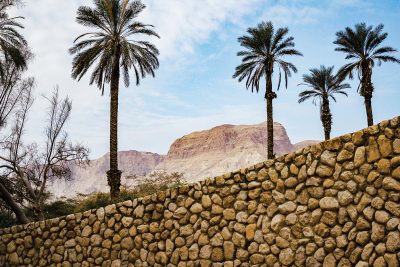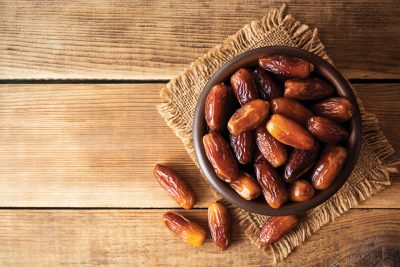×


We have detected your country as:
Please click here to go to the USA website or select another country from the dropdown list.
by: Sarah Yoder, BFP Staff Writer
 It was an exceptionally hot day in September when a small group of scientists gathered together in the heart of the Arava Desert. One by one they began to carefully harvest the luscious fruit of a date palm tree. But this was no ordinary date palm tree, for it had been pollinated by a tree grown from the oldest date seed in the world. The privileged few who took part in its first harvest that day tasted the fruit of a seed dating all the way back to the time of Jesus (Yeshua) and the Maccabees.
It was an exceptionally hot day in September when a small group of scientists gathered together in the heart of the Arava Desert. One by one they began to carefully harvest the luscious fruit of a date palm tree. But this was no ordinary date palm tree, for it had been pollinated by a tree grown from the oldest date seed in the world. The privileged few who took part in its first harvest that day tasted the fruit of a seed dating all the way back to the time of Jesus (Yeshua) and the Maccabees.
The story begins in the Judean wilderness in 1963. Excavations were well underway at Herod the Great’s palace in the Masada fortress when the exciting discovery was made: an ancient clay jar filled with date seeds. The dry environment inside the jar and the mounds of rubble surrounding it had managed to perfectly preserve the date seeds, and the carbon dating that followed confirmed that these seeds were well over 2,000 years old.
The seeds were kept in storage for over 40 years until Dr. Sarah Sallon initiated a project to germinate ancient seeds found at archeological sites in Israel. Sallon, a researcher of natural medicine, teamed up with Dr. Elaine Solowey, founder of the Center for Sustainable Agriculture at the Arava Institute for Environmental Research. They began by soaking the ancient date seeds in a combination of enzymatic water and fertilizer. A ceremony was held when the seeds were planted in January 2005 on Tu BiShvat (New Year for Trees). And two months later, the impossible happened: one of the seeds sprouted, becoming the oldest seed in the world to successfully germinate. Sallon affectionately named the seedling Methuselah after the oldest person mentioned in the Bible (Gen. 5:27).
As Methuselah grew, he attracted worldwide attention, and in 2008, this botanical miracle was officially added to the Guinness Book of World Records. This achievement would have been sensational enough, but the story doesn’t end here.
When Methuselah was transplanted to his now permanent home in the ground at the Arava Institute, it was confirmed that he is a male palm tree, meaning that a female would have to be pollinated to bear his fruit. And so Sallon once again set about germinating ancient date seeds, this time using seeds that had been discovered at Qumran. Once again the seeds sprouted, and—much to the delight of Sallon and Solowey—genetic testing revealed that one of the seeds was indeed a female. They named her Hannah and patiently waited for her to grow.
When Hannah flowered six years later, Solowey carefully collected pollen from Methuselah and brushed it onto Hannah’s flowers. This would be the true test of these ancient seeds: could they really reproduce after lying dormant for more than 2,000 years? The answer came as a triumphant “yes” when Hannah began to bear fruit. And so it was that in September 2020, in the midst of a global pandemic and economic collapse, an agricultural miracle took place in Israel as 111 dates were harvested from the oldest date seeds in the world.
 The date palm tree is arguably one of the most characteristic trees native to the Land of Israel. The first mention of dates in the Bible is when the Children of Israel left Egypt, entered the Elim Desert and pitched their tents next to 70 palm trees (Exod. 15:27). Date palms are most commonly found in desert climates such as Israel’s because they are extremely tolerant to drought. While the fruit is famous for its rich sugar content, it’s also praised for its nutritional value. Dates are rich in vitamins, high in antioxidants and loaded with fiber. This delightful combination, coupled with the resilient nature of a date palm, makes it easy to see why they are one of the oldest cultivated fruit trees in history.
The date palm tree is arguably one of the most characteristic trees native to the Land of Israel. The first mention of dates in the Bible is when the Children of Israel left Egypt, entered the Elim Desert and pitched their tents next to 70 palm trees (Exod. 15:27). Date palms are most commonly found in desert climates such as Israel’s because they are extremely tolerant to drought. While the fruit is famous for its rich sugar content, it’s also praised for its nutritional value. Dates are rich in vitamins, high in antioxidants and loaded with fiber. This delightful combination, coupled with the resilient nature of a date palm, makes it easy to see why they are one of the oldest cultivated fruit trees in history.
Date palms are praised all throughout the Bible as a symbol of righteousness, joy and victory. Carvings of date palms intricately adorned the walls of the inner and outer sanctuaries of Solomon’s Temple. Psalm 92 promises that the righteous will “flourish like a palm tree” (v. 12) and “still bear fruit in old age” (v. 14). Leviticus 23 tells us that the branches of the palm tree were used for decoration and waved in celebration during Sukkot (Feast of Tabernacles), a custom that is still honored today. Indeed, it would seem that the palm tree epitomizes the very essence of a pure heart filled with joy. It’s no wonder that palm branches were used to welcome Yeshua (Jesus) when He triumphantly entered Jerusalem, met by an enthusiastic crowd that proclaimed “Blessed is He who comes in the name of the Lord!” (John 12:13).
As one of the seven species native to the Land of Israel (Deut. 8:8), dates continue to play a key role in Israel’s economy. Today, the Jewish state produces more than 40,000 tons of dates annually, and dates are one of the top fruits exported from Israel. And while there are hundreds of varieties of dates worldwide, Israel controls 65% of the world’s Medjool date market, a luscious variety that has become increasingly trendy in the 21st century.
The miracle of an ancient seed sprouting and producing a fresh harvest serves as a reminder of the enduring nature of life. “To bring something back to life from dormancy is so symbolic,” Sallon told the New York Times on the day the dates were harvested. “To pollinate and produce these incredible dates is like a beam of light in a dark time.”
How very true. If a small, once forgotten seed can be transformed from fallow to fruitful, how much more can we revive the hope that is within us?
Photo Credit: Click on photo to see photo credit
All logos and trademarks in this site are property of their respective owner. All other materials are property of Bridges for Peace. Copyright © 2025.
Website Site Design by J-Town Internet Services Ltd. - Based in Jerusalem and Serving the World.